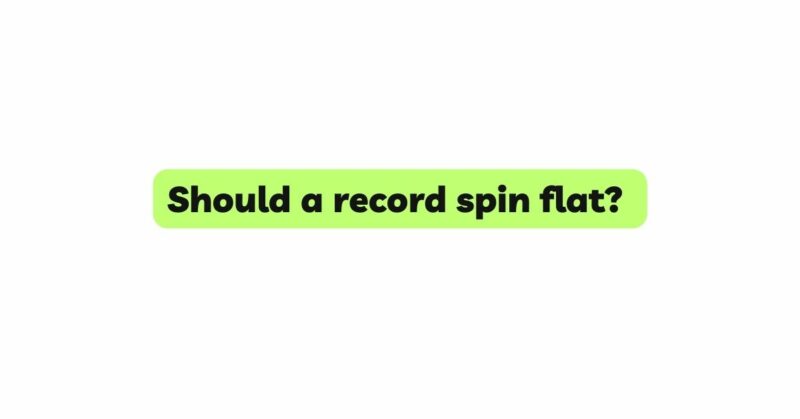The world of vinyl records and turntables has experienced a remarkable resurgence in recent years, captivating a new generation of music enthusiasts. In the midst of this revival, a longstanding question continues to spark debates among audiophiles and collectors: Should a record spin flat? Traditionally, vinyl records have been played flat on turntables, but the emergence of alternative playback methods has challenged this convention. In this article, we delve into the arguments surrounding record orientation, examine its impact on audio quality, and explore the validity of non-flat record playback. By seeking clarity on this contentious topic, we aim to guide music enthusiasts in making informed decisions about their vinyl listening experience.
- The Tradition of Flat Record Playback:
For decades, the standard practice for playing vinyl records involved placing them flat on turntable platters. The record would rotate clockwise or counterclockwise, while the stylus (needle) would trace the grooves in the record, converting the analog information into sound waves.
Advantages of Flat Record Playback: a. Stability: Flat playback ensures that the record remains stable and evenly contacts the turntable platter, reducing vibrations and minimizing potential sound distortions. b. Optimal Stylus Alignment: With a flat record, the stylus maintains accurate alignment with the grooves, maximizing sound quality and minimizing wear on both the record and stylus. c. Widespread Support: Turntables and record players are designed with flat record playback in mind, making it the most widely accepted and supported method.
- The Rise of Non-Flat Record Playback Methods:
a. Vertical Turntables: In recent years, vertical turntables have gained popularity as a unique and visually striking approach to playing records. In this setup, the record is mounted vertically on a wall or stand, and the stylus tracks the grooves as the record spins vertically.
Advantages of Vertical Turntables: i. Space-Saving: Vertical turntables are ideal for smaller living spaces or wall-mounted installations, offering a stylish and space-efficient solution for audiophiles with limited room. ii. Aesthetic Appeal: The visually captivating aspect of a vertically spinning record adds an artistic and modern touch to interior decor, elevating the experience of vinyl listening.
b. Wall-Mounted Turntables: Wall-mounted turntables are a variation of vertical turntables where the entire turntable mechanism is attached to a wall, and the record spins vertically.
Advantages of Wall-Mounted Turntables: i. Space Optimization: Wall-mounted turntables efficiently use wall space and can be positioned at eye level for easy access and visual enjoyment of vinyl collections. ii. Conversation Starter: Wall-mounted turntables become a focal point and conversation starter, turning vinyl collections into a conversation piece and enhancing the aesthetics of a room.
- Addressing the Impact on Audio Quality:
Audiophiles and vinyl enthusiasts have expressed concerns about the impact of non-flat playback on audio quality. Critics argue that playing records vertically could potentially introduce mechanical stress on the record and affect stylus tracking, leading to unwanted surface noise and distortion.
However, proponents of non-flat playback methods argue that advancements in turntable technology and stylus design have mitigated these concerns. With proper setup, calibration, and adjustments, vertical and wall-mounted turntables can deliver a pleasing listening experience with minimal impact on audio quality.
- The Role of Turntable Calibration and Adjustments:
Whether playing records flat or non-flat, precise calibration and setup are crucial to achieving satisfactory audio performance. Turntables must be accurately aligned, and tracking force and anti-skate adjustments need to be meticulously configured to optimize audio quality.
Properly calibrated turntables can minimize any potential negative effects associated with non-flat playback, ensuring that the stylus accurately tracks the grooves and delivering an enjoyable listening experience.
- Individual Preferences and Aesthetics:
The choice between flat and non-flat record playback methods ultimately depends on individual preferences and aesthetic considerations. Some audiophiles prioritize audio fidelity and prefer the traditional, flat playback method for its familiarity and support. On the other hand, others value aesthetics and space efficiency, favoring vertical or wall-mounted turntables as a way to incorporate vinyl collections into interior decor.
- Exploring the Middle Ground: Hybrid Solutions
In the pursuit of the best listening experience, some audiophiles adopt hybrid solutions that combine elements of both flat and non-flat playback. For instance, some turntable models allow users to switch between horizontal and vertical orientations, offering the best of both worlds.
- The Magic of Vinyl: Preserving the Joy of Listening
Regardless of the orientation of the record, the true essence of vinyl lies in the nostalgic and tactile experience it offers. The unique process of physically placing a record on the turntable, carefully lowering the stylus onto the grooves, and immersing oneself in the warmth and richness of analog sound is what makes vinyl listening truly magical.
Conclusion:
The debate over whether a record should spin flat or not is a reflection of the vibrant and passionate vinyl community. While flat record playback remains the traditional and widely supported method, alternative playback approaches, such as vertical and wall-mounted turntables, have gained popularity for their unique aesthetics and space-saving attributes.
Advancements in turntable technology and stylus design have addressed concerns related to non-flat playback, ensuring that properly calibrated setups deliver a satisfying audio experience. Ultimately, the choice between flat and non-flat record playback methods is a matter of personal preference, aesthetics, and space considerations.
Regardless of the orientation, the enchantment of vinyl lies in the nostalgic experience it offers, creating a timeless connection between the listener and the music. Embracing the diverse methods of vinyl playback allows each audiophile to craft a unique and enjoyable vinyl listening experience that resonates with their individual tastes and lifestyle.


